Are you tired of having weak, underdeveloped calves? Look no further than the seated calf raise exercise. This move targets your calf muscles and can lead to improved strength, stability, and injury prevention.
Try these simple yet effective seated calf raise exercises for strengthening your calf muscles. You can do this calf raise variation with dumbbells, barbell and with a machine.
Strong and well-developed calf muscles not only contribute to an impressive physique, but also play a vital role in overall lower body strength and stability.
Read on to know more about the following topics:
- Know About Calf Muscles
- What Is A Seated Calf Raise?
- Seated Calf Raises Muscles Worked
- How To Do it
- Its Benefits
- Seated Calf Raise Benefits
- Its Alternatives

- Know About Calf Muscles (Anatomy)
- Gastrocnemius
- Soleus
- What Is a Seated Calf Raise?
- Seated Calf Raises Muscles Worked
- How To Do Seated Calf Raise
- Set up the Equipment
- Starting Position
- Execution
- Tips For Proper Form
- Seated Calf Raise Benefits
- 1. Increased strength and tone in the calf muscles
- 2. Improved ankle stability and balance
- 3. Reduced risk of injury in activities that involve the calf muscles
- 4. Improve sports performance
- 5. Help with daily activities
- 6 Prevent shin splints
- The difference between standing and sitting calf raises?
- 5 Best Variation Of Seated Calf Exercise
- 1. Seated Dumbbell Calf Raise
- 2. Seated Machine Calf Raise
- 3. Seated Dumbbell One Leg Calf Raise
- 4. Barbell Seated Calf Raise
- 5. Smith Seated Calf Raise
- Seated Calf Raise Alternatives
- 1. Standing Calf Raise
- 2. Donkey Calf Raise
- 3. Smith Machine Standing Calf Raise
- Sets, Reps, and Frequency For Seated Calf Raise
- For Strength
- Hypertrophy
- For Endurance
- Frequency
- People also ask
- Seated calf raise vs. standing Calf Raise
- Seated vs. standing calf raise muscles worked
- How many sitting calf raises should I do?
- Are seated calf raises better than standing?
- How to Do Seated Calf Raises at Home?
- Takeaways
- References
- Related Posts
- 10 Best Calf Exercises To Build Bigger and Stronger Calves Quickly
Know About Calf Muscles (Anatomy)
But before starting to implement the calf training routine, let understand a bit about calves muscles.
The calf muscle is located in the lower leg and is made up of two main muscles: the gastrocnemius and the soleus.
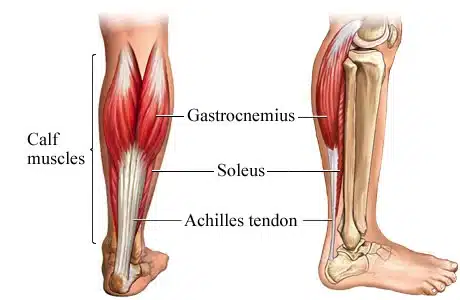
Gastrocnemius
The gastrocnemius is the larger and more superficial of the two muscles. It creates the “bulging” appearance of the calf.
It originates at the back of the knee and inserts into the heel bone (calcaneus) via the Achilles tendon.
This muscle is responsible for plantar flexion of the foot and is heavily involved in activities such as running and jumping.
Soleus
The soleus is a smaller, deeper muscle that lies underneath the gastrocnemius. It also originates at the back of the knee and inserts into the heel bone, but it does so directly rather than via the Achilles tendon.
The soleus is primarily responsible for plantar flexion of the foot and is active in activities such as walking and standing.
Both of these muscles work together to control movement of the ankle and foot, and they also play a role in stabilizing the knee.
Training these muscles can help prevent injury and improve overall leg strength and function.
What Is a Seated Calf Raise?
A seated calf raise is a weight training exercise that targets the calf muscles (soleus and gastrocnemius). The exercise is performed while seated, with the feet positioned on a platform and the weight on the thighs.
The movement involves lifting the weight by extending the ankle, and lowering it by flexing the ankle.
The seated calf raise is often performed using a machine specifically designed for this exercise, which allows the user to adjust the weight and the angle of the foot platform.
The machine also holds the user in a seated position and supports the knee, which allows for a more controlled and isolated movement of the calf muscles.
It can also be done with a barbell or dumbbells in a seated position on a bench.
Seated Calf Raises Muscles Worked
Seated calf raises primarily target the soleus muscle, which is a uni-articular muscle located under the gastrocnemius.
The gastrocnemius muscle, a bi-articular muscle, which is also involved in plantar flexion and knee flexion, is a secondary muscle target while performing seated calf raises.
Because the knee is held in a fixed position during this exercise, the gastrocnemius cannot fully contract, which allows the soleus to be the primary muscle worked.
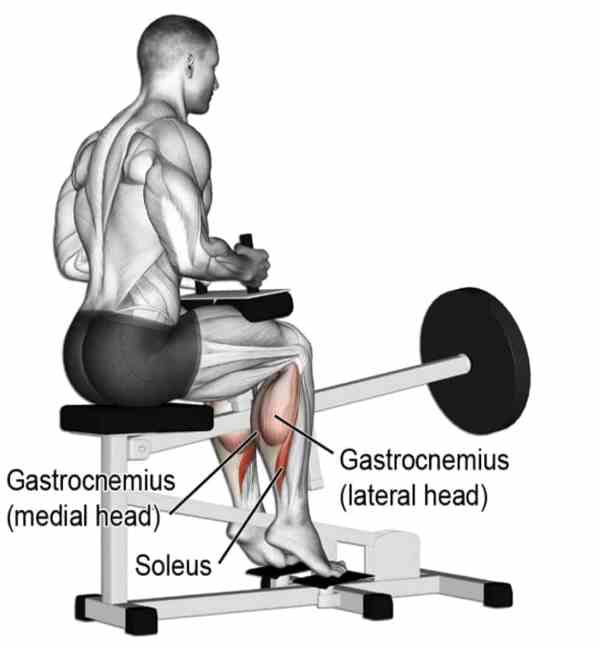
How To Do Seated Calf Raise
Here’s a step-by-step guide on how to do seated calf raises:
Set up the Equipment
- Locate a seated calf raise machine at your gym, or use dumbbells and barbells if a calf machine is not available.
- Adjust the seat height and footplate position to ensure proper alignment and comfort.
- Set the desired weight on the machine or choose appropriate dumbbells for resistance.
Starting Position
- Sit on the machine with your back straight and feet resting on the footplate.
- Position the balls of your feet on the edge of the footplate, with your heels slightly hanging off.
- Place your hands on the handles or sides of the machine for stability.
Execution
- Engage your core and maintain an upright posture.
- Slowly lower your heels by flexing your ankles, allowing them to drop below the footplate.
- Pause briefly at the end of the movement to stretch your calf muscles.
- Contract your calf muscles and raise your heels as high as you can by extending your ankles.
- Squeeze your calf muscles at the top of the movement for a second.
- Repeat the movement for the desired number of repetitions.
Tips For Proper Form
- Focus on a slow and controlled tempo, such as a 3-second eccentric (lowering) phase, a pause at the bottom, a 3-second concentric (lifting) phase, and a pause at the top.
- Keep your heels up while you’re doing your seated calf raise to avoid releasing tension when your heels touch the ground.
- Strengthen the mind-muscle connection and make the calves’ workout more effective and focused.
- Avoid leaning back or compromising your posture during seated calf raises. Sit upright with a neutral spine and engaged core.
- During the exercise, focus on pressing through your balls of your feet instead of your toes.
- Imagine sitting at a 90-degree angle and keeping this position to avoid strain on the lower back and maximize calf muscle engagement.
- Perform seated calf raises with a full range of motion. Lower your heels as far as possible and raise them as high as possible, while maintaining control and proper form.
- Do not turn your feet excessively. Make sure your feet are aligned with your legs and that you avoid inward or outward rotation.
Seated Calf Raise Benefits
Your calves help stabilize and strengthen your ankles, allowing your feet to leave and hit the ground properly when you do everything from walk to jump.
Seated calf raises have several benefits, including:
1. Increased strength and tone in the calf muscles
The calf muscles are responsible for many movements and activities, such as walking, running, and jumping. Strong calf muscles are important for overall leg strength and function, and can help prevent injury.
2. Improved ankle stability and balance
The calf muscles play a key role in maintaining stability and balance in the ankle joint. Strong calf muscles can help to improve proprioception and balance, which can help to reduce the risk of ankle sprains.
3. Reduced risk of injury in activities that involve the calf muscles
As mentioned before, strong calf muscles can help prevent injury by providing support and stability to the ankle and knee joints.
4. Improve sports performance
Calf muscles are important in many sports, including running, jumping, and soccer. Strong calf muscles can help to improve power, speed, and endurance in these activities.
5. Help with daily activities
Strong calf muscles can make everyday activities such as climbing stairs, walking, and standing easier and less fatiguing.
6 Prevent shin splints
Shin splints are common in athletes and people who are active, and are often caused by weak calf muscles. Strengthening the calf muscles with exercises like seated calf raise can help to prevent shin splints by providing support to the muscles and bones in the lower leg.
The difference between standing and sitting calf raises?
The main difference between a seated and standing calf raise is that your legs are bent when seated and straight when standing.
Sitting raises mainly target the soleus, and standing calf raises focus on the gastrocnemius.
The seated calf raise can be performed with dumbbells or a machine. But the common seated calf raise is done using resistance such as weight plates or dumbbells.
5 Best Variation Of Seated Calf Exercise
Take a look at these 5 Best seated calf raises workouts and training exercises for the best calves around.
1. Seated Dumbbell Calf Raise
If you are looking for a calf raise exercise that you can do at home or gym, then seated dumbbell calf raises are perfect for training the soleus calf muscle.
When performing the seated version of the calf raises, it’s important to get a good stretch on the bottom and squeeze at the top, that way you will hit every muscle fiber available.
Sometimes it’s hard to get a good pump in the calf muscle, so make sure to add enough weight and reps.

How To Do Seated Dumbbell Calf Raise
- Use a seated calf raise machine or sit on a bench and rest the balls of your feet on a block or plates and hold dumbbells on your thighs for resistance.
- Your knees should be bent 90 degrees and your toes pointing straight ahead.
- Allow your heels to drift toward the floor until you feel a stretch in your calves.
- Now drive the balls of your feet into the platform and raise your heels as high as possible.
- Repeat the desired number of reps.
Tips
- Move slowly as you stretch your calf muscle.
- Make sure you hold the stretch for a second at the top, returning to the starting position.
- Engage your core to keep your torso upright throughout the exercise.
2. Seated Machine Calf Raise
The seated calf raise is a one of the best strength-gaining exercises that targets your calf muscles and accelerates their growth.
It specifically activates and stresses the soleus calf muscle, and so the exercise is best performed by maintaining an angle of 90 degrees at the knees.
In the seated calf raise, your soleus is the target and your gastrocnemius is the synergist.
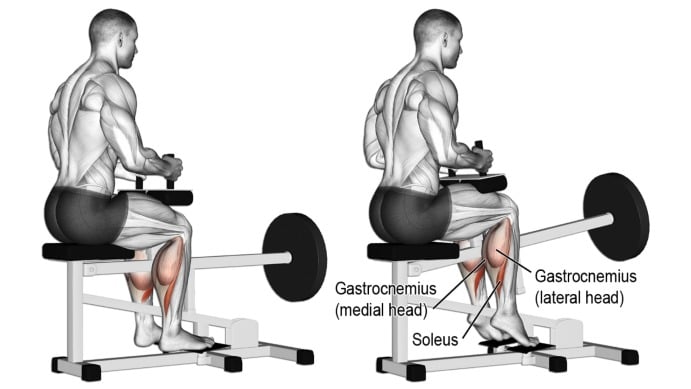
How To Do Seated Machine Calf Raise
- Sit in the seated calf machine and place your feet on the foot plate so that your heels hang off the edge.
- Place the knee pad on your knees and unrack the weight.
- Drop your heels as low as you can to get a good stretch in your calves.
- Lift your heels by contracting the calf muscles to raise the weight as high as you can on the balls of your feet.
- Hold this position for a second, flexing your calf muscles, then lower your heels back to the starting position.
Tips
- Do the reps in a controlled way and limit momentum at the top of the movement.
- Use the maximum range of motion by allowing your heels to drop as far as possible and then raising them as high as possible.
3. Seated Dumbbell One Leg Calf Raise
The seated dumbbell one-leg calf raise exercise places more stress on the soleus than it does on the gastrocnemius.
It may also be performed with both legs simultaneously, but doing it one leg at a time is recommended to execute it as properly and safely as possible.
If there are size and strength differences between your calves, perform this exercise first on your smaller or weaker calf, and do not perform more reps on your stronger calf. This allows your weaker calf to catch up in strength.

How To Do Seated Dumbbell One Leg Calf Raise
- Sit with the front of your right foot placed on top of a block or step in front of you.
- Hips and knees should be bent at a ninety-degree angle.
- Dip the heel of your right foot as low as it can go.
- Hold a dumbbell vertically on top of your right knee.
- Exhale as you lift your right heel as high as possible, pushing against the dumbbell’s weight.
- Keep your right heel lifted for 2 counts. Slowly lower it as you inhale.
- Repeat the desired number of repetitions.
- Then repeat the exercise on your left foot.
Tips
- Move slowly as you stretch your calf muscle.
- Make sure you hold the stretch for a second at the top, returning to the starting position.
- Engage your core to keep your torso upright throughout the exercise.
4. Barbell Seated Calf Raise
The barbell seated calf raise is a great variation of the seated calf raise if you have limited equipment (e.g., a home setup). But you can still utilize it as a gym exercise as well.
This is a very useful exercise if you don’t have access to a seated calf raise machine.
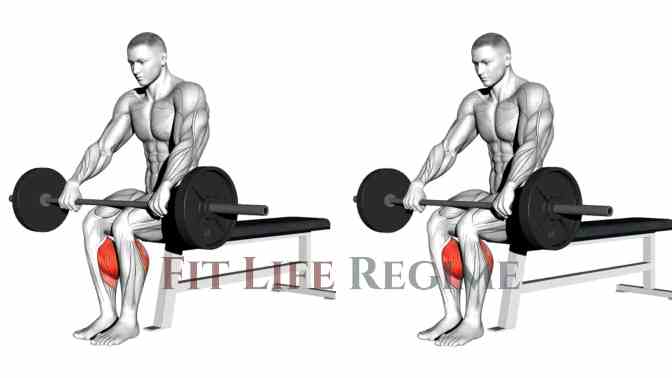
How To Do Barbell Seated Calf Raise
- Sit on the end of a bench, chair, and place the barbell on the end of your thighs near your knee but not on your knee.
- Sit up straight and place the top half of your feet or balls of your feet on the floor or elevated object so that your heels are hanging off.
- Lift your heels by contracting the calf muscles to raise the weight as high as you can on the balls of your feet.
- Hold this position for a second, flexing your calf muscles, then lower your heels back to the starting position.
Tips
- Have a firm grip on the barbell to keep in it in one place.
- Perform the reps nice and slow using a full range of motion.
5. Smith Seated Calf Raise
Smith Seated Calf Raise exercise is a great alternative to the seated calf raise machine.
It is usually performed for moderate to high reps, such as 8-12 reps per set or more, as part of the lower-body portion of a workout.
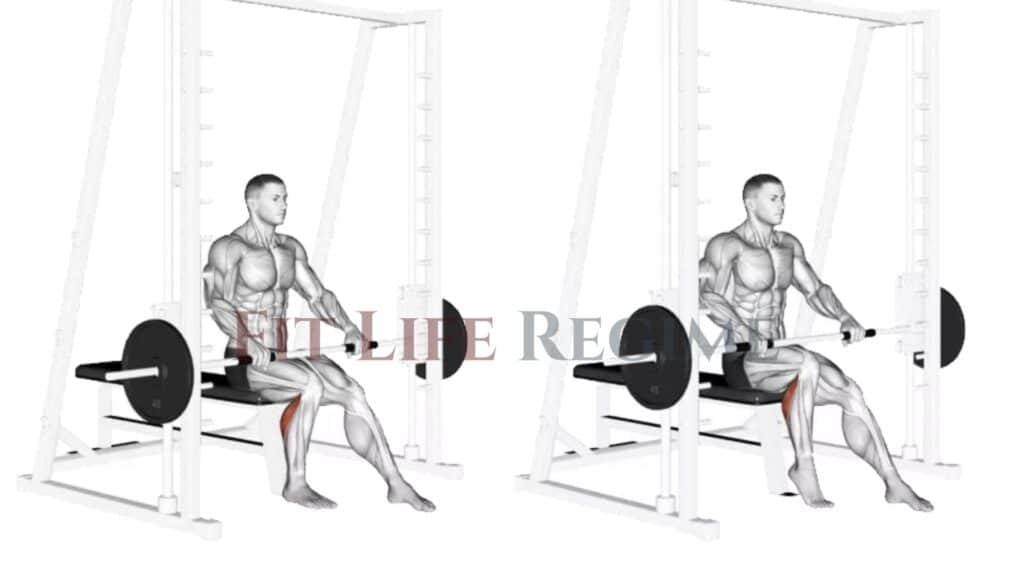
How To Do Smith Calf Raise
- Set up for the smith machine seated calf raise by placing a flat bench in the smith machine and putting a step or placing a foot flat on the floor.
- Sit on the end of the bench and the ball of your one-foot on the floor. Take the bar off the rack and rest it on your right thigh.
- Lift your heel of the right foot by contracting the calf muscles to raise the weight as high as you can on the balls of your feet.
- Hold this position for a second, flexing your calf muscles, then lower your heels back to the starting position.
- Repeat for desired reps.
Tips
- Keep the rep timing slow and controlled, lowering the weight slowly.
Seated Calf Raise Alternatives
Of course, you don’t have to do seated calf raises in every workout. There are some other great exercises you can do to hit your lower legs from additional angles and target different calf muscles.
1. Standing Calf Raise
Calf exercises are performed to build 2 basic calf muscles, soleus, and gastrocnemius.
If there is only one exercise you want to do for your calves, then it should be calf raises. It is the overall Calf muscle builder.
Standing calf raise targets the whole gastrocnemius muscle.
A wide stance tends to emphasize the inner (medial) head, whereas a narrow stance targets the outer (lateral) head.

2. Donkey Calf Raise
Donkey Calf Raise is one of the best calf exercises to build calf muscles. This raise is mostly the second option after standing calf raises.
The donkey calf raise primarily targets both muscles that make up the calves: the gastrocnemius and the soleus.
The donkey calf raises secondarily activates the hamstrings and abs. When you bend over to initiate the calf raise, the hamstrings receive a stretch. Add this exercise as a variation to your calf workouts.

3. Smith Machine Standing Calf Raise
The Smith machine standing calf raise is a machine-based exercise targeting the muscles of the calves, particularly the gastrocnemius or upper calf muscle.
It is usually performed for moderate to high reps, such as 12-20 reps per set or more, as part of the lower body portion of a workout.
Sets, Reps, and Frequency For Seated Calf Raise
For Strength
- 3 sets of 6-8 reps of seated calf raises into your lower body workout days.
Hypertrophy
- Aim for 3-4 sets of 10-12 reps.
- Focus on using an extra slow tempo for both the eccentric (lowering) and concentric (lifting) phases of the exercise.
For Endurance
- Perform 3-4 sets of 15-20 reps
- Be cautious not to rely on momentum or shorten your range of motion during the exercise.
Frequency
The soleus muscle, primarily composed of slow-twitch muscle fibers, can tolerate more frequent training compared to other muscle groups.
If your calves need extra attention in terms of size or strength, consider training them three days a week. Pick the days that work best for you and stick to the same routine for your calves.
People also ask
Seated calf raise vs. standing Calf Raise
The main difference between seated and standing calf raises is that when you are doing them standing, with a straight knee, you are targeting the gastrocnemius, whereas seated calf raises target the soleus.
Here are some more differences in the way the exercises are performed.
Seated calf raises:
- This exercise is performed while seated, with the feet positioned on a platform.
- The knee is held in a fixed position and the movement involves lifting the weight by extending the ankle, and lowering it by flexing the ankle.
- The seated position allows for a more controlled and isolated movement of the calf muscles.
- Primarily targets the soleus muscle and secondary the gastrocnemius muscle.
Standing calf raises:
- This exercise is performed while standing, with the feet positioned on a platform.
- The knee is not held in a fixed position and the movement involves lifting the weight by extending the ankle, and lowering it by flexing the ankle.
- The standing position allows for more recruitment of the gastrocnemius muscle.
- Primarily targets the gastrocnemius muscle and secondary the soleus muscle.
It is recommended to include both exercises in your workout routine to target both muscle groups and get the most benefits.
Seated vs. standing calf raise muscles worked
Seated calf raises and standing calf raises both target the calf muscles (gastrocnemius and soleus) in the lower leg, but there are some differences in the muscles that are targeted and the way the exercises are performed.
- Standing calf raises primarily target the gastrocnemius muscle and secondary the soleus.
- While seated calf raises primarily target the soleus muscle and secondary the gastrocnemius.
Both exercises are effective for targeting the calf muscles and can be used to improve calf muscle strength and tone, increase ankle stability and balance.
How many sitting calf raises should I do?
As a general guideline, you can start with 2-3 sets of 12-15 reps of calf raises, with a weight that allows you to perform the exercise with proper form and still challenge your muscles.
You can gradually increase the weight and/or reps as you get stronger and your muscles adapt to the exercise.
For beginners, it’s important to start with a weight that is comfortable for you and not to push too hard.
It’s better to start with a lower weight and focus on proper form and technique, then increase the weight as you get stronger.
Incorporating calf exercises into your routine 2-3 times per week are a good idea.
Are seated calf raises better than standing?
It’s hard to say which exercise is better, as it depends on the individual’s goals and muscle strength.
If you’re looking to target and strengthen your soleus muscle, seated calf raise will be more beneficial, whereas if you’re looking to target and strengthen your gastrocnemius muscle, standing calf raise will be more beneficial.
In fact, it is recommended to include both exercises in your workout routine to target both muscle groups and get the most benefits.
How to Do Seated Calf Raises at Home?
You can do seated calf raises at home by using a chair and a heavy object on top of your knees. Home workout enthusiasts have been known to use water jugs or books, while dumbbells and weight plates are the standard.
Takeaways
The seated calf raise is a great way to increase strengthen the calves muscles and improve your performance in and outside the gym.
The seated calf raise can also be combined with other calf exercises for strong and chiseled legs.
References
- ACE: “Weight Lifting Tempo & Sets: How to Select the Right Sets for Your Clients”
- The Effect of Calf-Raise Exercise on Gastrocnemius Muscle Based on Other Type of Supports
- Lee, Geoncheol & Kim, Bom & Kim, Jisu & Nam, Inseong & Park, Yoojin & Shin, Woojin & Woo, Sumin & Cha, Seongki. (2014). The Effect of Calf-Raise Exercise on Gastrocnemius Muscle Based on Other Type of Supports. Journal of The Korean Society of Integrative Medicine. 2. 10.15268/ksim.2014.2.1.109.
Related Posts
- 12 Best Calf Exercises and Workout for Building Bigger Calves
- 15 Best Barbell Leg Workout For Mass and Strength
- 15 Best Leg Exercises and Workout for Muscle & Strength
- 12 Most Effective Smith Machine Leg Workout & Exercises
10 Best Calf Exercises To Build Bigger and Stronger Calves Quickly

Manish brings over 10 years of hands-on experience in weight lifting and fat loss to fitness coaching. He specializes in gym-based training and has a lot of knowledge about exercise, lifting technique, biomechanics, and more.
Through “Fit Life Regime,” he generously shares the insights he’s gained over a decade in the field. His goal is to equip others with the knowledge to start their own fitness journey.
